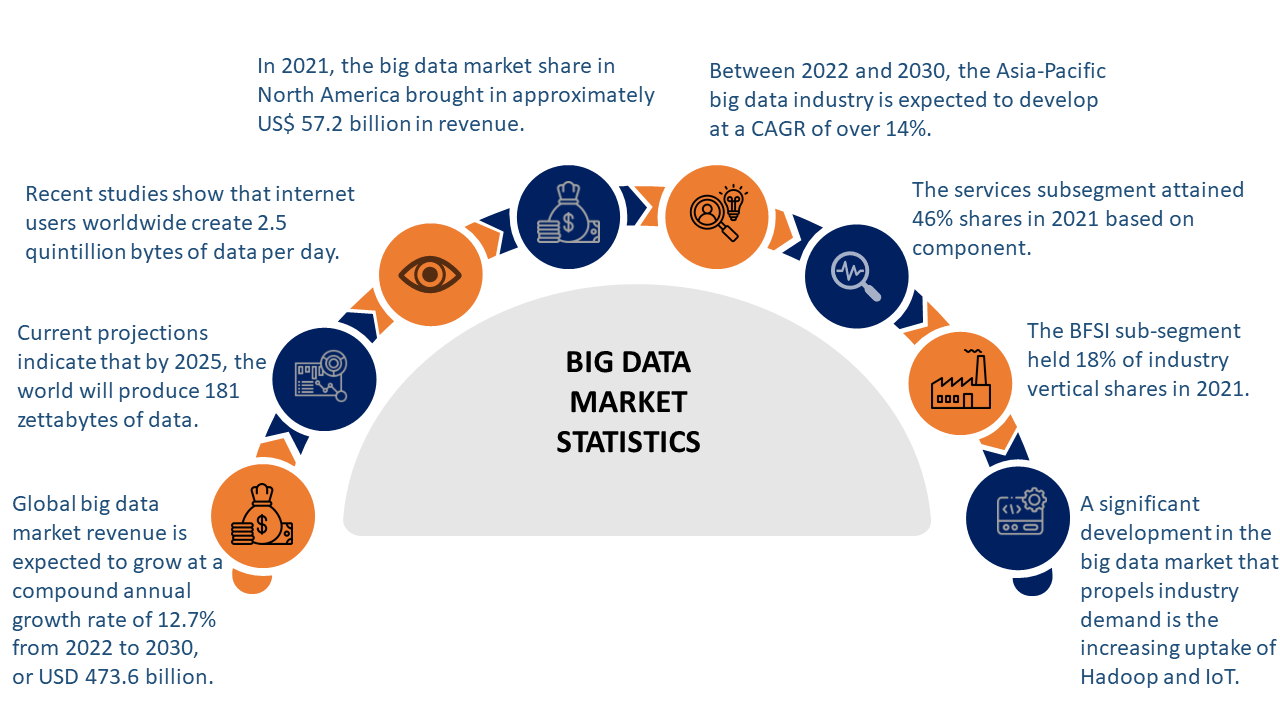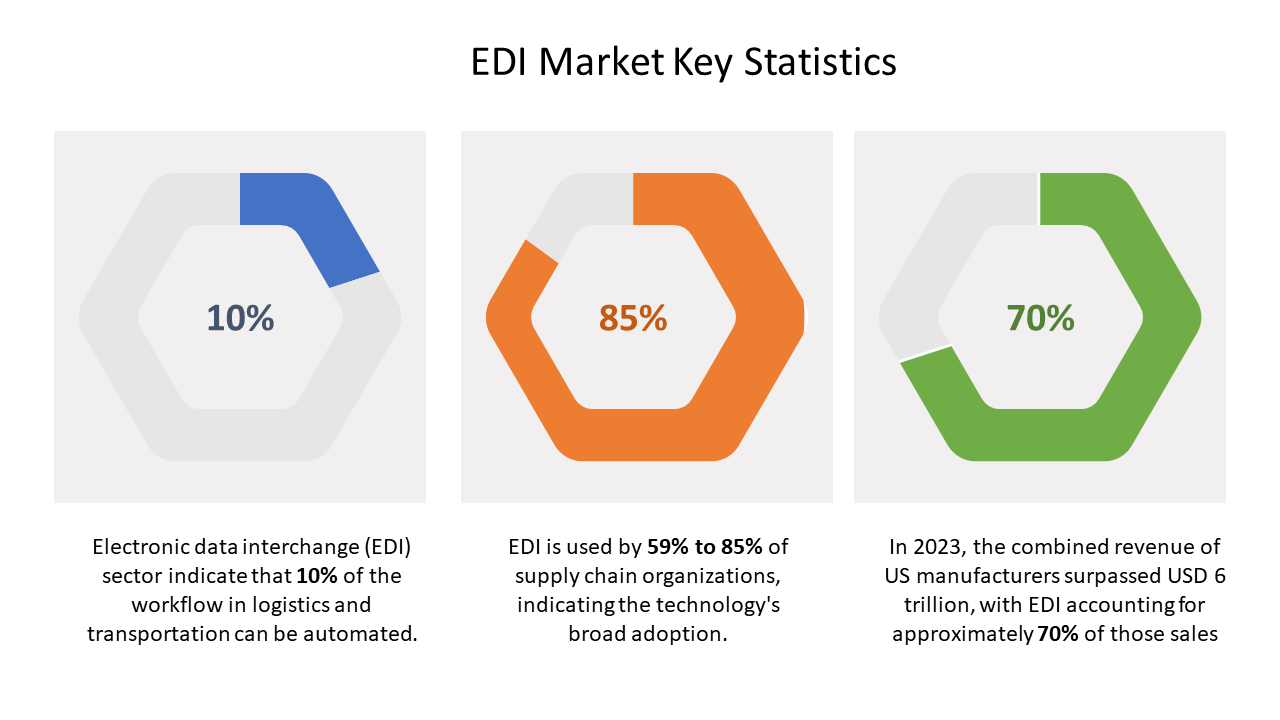Table of Contents
According to Forbes Insights, data is the DNA behind powerful analytics and insights. They support current organizations to sense new opportunities, decide how to serve clients better, and improve functional efficiencies. Organizations that embrace data analytics and EDI have essentially more development than those that postpone it. These organizations are likewise characterized by having thorough digitization of data and the reception of analytics.
Not precisely half of businesses are utilizing big data frameworks effectively. Not all strategies are planned ideally. Furthermore, to see the critical effect of data usage on sales and complete profitability, you should follow a few key strategies.
Anderson argues that once you have access to big data, there is no need to ‘settle for models. He notes that in the ‘Petabyte Era’, “information is not a matter of simple three- and four-dimensional taxonomy and order, but dimensionally agnostic statistics” (Anderson, 2008)
Data Analytics & EDI: An overview
In the quickly developing digitized scene, powerful communication and consistent data exchange are major for organizations to flourish. One innovation that has transformed this perspective is Electronic Data Interchange (EDI). Furthermore, the worldwide EDI market is projected to be nearly $6 billion by 2025, indicating a CAGR of 9.4%, according to Grand View Research.
In this outlined guide, we will dig into EDI’s significance, job, and fate, and why A3Logics, a data analytics services company, is the believed partner for organizations trying to use this groundbreaking service. This reservoir of data, known as Big Data, presents various open doors for organizations to acquire bits of knowledge and go with data-driven choices. Furthermore, as per Statista, the Big Data Analysis industry is expected to develop from around $241 billion in 2021 to north of $655 billion by 2029.
The worth of this data can be extended effectively by managing and studying it well. According to Statista, by 2025, the aggregate sum of data generated overall will be somewhat north of 180 zettabytes. For that reason, big data can become overpowering to break down without viable management, bringing about mishandled open doors and unfortunate direction. To completely use big data, efforts should take an interest in effective data management advancements. Furthermore, in this blog, we’ll analyze the benefits of big data analysis in business.
Unlock What Data Can Do For Your Business
What is Data Analytics?
Data analytics is the study of analyzing raw data to make decisions. Mechanical cycles and computations have been developed to digitize a significant number of data analytics solutions and processes, working over raw data for human usage. It is an expansive term that incorporates numerous different kinds of data analysis. Any sort of data can be exposed to data analytics methods to get an understanding.
Data analytics methods can uncover trends and measurements that would otherwise be lost in the mass of data. Companies can then use this data to improve processes and increase the overall productivity of a business or system.
For instance, producing organizations frequently record the runtime, margin time, and work line for different machines and afterward analyze the data to more readily design jobs so the machines work nearer to the top limit.
Role of Data Analytics
Data analytics is significant because it assists businesses with advancing their collections. Executing it into the business model means organizations can assist with decreasing expenses by identifying more effective approaches. To carry on with work and the overwhelming data. An organization can likewise utilize data analytics to make better business decisions. It can assist with analyzing client trends and fulfillment, which can produce new and better items and services.
Different industries use data analytics in their processes . For instance, gaming organizations use data analytics services to set reward plans for players that keep most players dynamic in the game. While content organizations utilize a large number of similar data to keep you clicking, watching, or re-sorting out happily.
Importance of Data analytics in modern business
Data analytics plays a basic part in present-day business because of multiple factors:
- Better Independent direction:
Data analytics furnishes businesses with the data they need to pursue informed choices. Furthermore, by analyzing data, businesses can distinguish examples and trends that can assist them with making forecasts and recognizing new open doors.
- Expanded Effectiveness:
Data analytics can assist businesses with advancing their activities by recognizing areas of shortcomings and waste. By analyzing data, stock, and store management, businesses can distinguish valuable chances to smooth out their activities and decrease costs.
- Further developed Consumer loyalty:
Data analytics can assist businesses in acquiring a superior awareness of their clients. By analyzing data on client conduct and inclinations, businesses can promote more designated showcasing efforts. Further develop client support, and make items and services that better address client issues.
- Competitive Advantage:
In the present profoundly competitive market, businesses that can successfully dissect and decipher data enjoy a particular benefit. By utilizing data analytics, businesses can remain in front of their rivals by recognizing arising trends and settling on additional educated choices.

How Can Businesses Implement Data Analytics?
Executing data analytics can appear to be overwhelming, particularly for independent companies with restricted assets. Be that as it may, there are a few stages businesses can take to get everything rolling:
1. Recognize Objectives:
Before carrying out data analytics, businesses ought to distinguish their objectives and what they desire to accomplish. This will assist them with figuring out what data to gather and how to examine it.
2. Collect Data:
Businesses ought to gather applicable data from different sources, for example, client exchanges, site analytics, and virtual entertainment movement.
3. Investigate Data:
Whenever businesses gather data, they ought to examine it utilizing statistical and computational techniques to recognize patterns, trends, and insights.
4. Execute Changes:
Given the experiences acquired from data analytics, businesses ought to change their tasks, and showcase methodologies, or items and services.
Data analytics is a fundamental apparatus for current businesses hoping to make progress in the present exceptionally competitive market.
By giving businesses the data they need to go with informed choices, streamline their tasks, and further develop consumer loyalty, data analytics can assist businesses with accomplishing their objectives and gaining an upper hand. With the right methodology and assets, any business can execute data analytics and receive its rewards.
Applications of Data Analytics in Different Industries
1. Security
Security staff use data analytics (especially predictive analytics) to distinguish future events of misconduct or security breaks. They can likewise investigate past or continuous attacks. During an assault, analytics assesses how IT frameworks were compromised and also examines other potential defects, as well as the behavior of end clients or gadgets involved in security.
A few urban communities use analytics to screen horror locales. They screen wrongdoing examples and utilize these examples to anticipate future wrongdoing prospects. Furthermore, this assists with protecting the city without jeopardizing cops’ lives.
2. Transportation
Data analytics can play a significant part in reforming the transportation business. It is particularly helpful for shipping countless individuals to a specific area that requires consistent transportation.
The data analysis procedure was utilized by the 2012 London Olympics by organizers. Moreover, approximately 18 million voyagers were projected for the event.
Subsequently, train services and TFL had the option to utilize data from past events to conjecture the number of individuals who might travel and afterward guarantee that transportation stayed consistent.
3. Risk Management
Risk management is a central issue in the protection area. In the process of safeguarding an individual, it is often overlooked that the risk involved is calculated using data that has been meticulously examined before any decision is made.
Data analytics gives protection firms data on claims data, actuarial data, and hazard data, covering all key choices that the organization should make.
Before protection is afforded to an individual, an assessment of that person is conducted by a guarantor, and an appropriate determination is made without a definitive conclusion.
4. Delivery
There are innumerable purposes for data science and analytics. A few calculated organizations all over the planet, for example, UPS, DHL, and FedEx, use data to work on their functional effectiveness.
These businesses have found the best transportation courses, the best conveyance times, the most practical methods of transportation, and numerous different things because of data analytics applications.
Besides, the data gathered by these organizations using GPS furnishes them with numerous chances to utilize data analytics and data science services.
5. Customer Interactions
This is one more illustration of a data analytics application in protection. By leading customary client studies, essentially after interfacing with guarantee overseers, safety net providers can glean some useful knowledge about their services. Furthermore, They use this to figure out which of their services are successful and which should be gotten to the next level.
Various populaces might favor various methods of communication, for example, in-person connections, sites, calls, or simply email. Utilizing buyer segment data and input, guarantors might further develop client experience given client conduct and demonstrated bits of knowledge.
6. Healthcare
Most medical clinics face the challenge of managing cost pressures while treating as many patients as possible and simultaneously improving healthcare quality.
The utilization of machine and instrument data to enhance and track treatment, patient stream, and hardware use in clinics has expanded decisively. Researchers assess that a 1% productivity gain results in roughly $63 billion in worldwide medical care services.
7. Education
Policymakers can utilize data analytics to enhance educational programs and decision-making. These applications would improve both learning and authoritative administration.
To work on the educational plan, you can gather inclination data from each student and use it to make an educational plan. This would bring about a superior framework in which understudies gain proficiency with similar subjects in more than one way.
Moreover, data gathered from understudies can help in better asset allocation and long-term the executive’s choices. For instance, data analytics could inform chairmen about the offices that students use the least or the subjects in which they have the least interest.
8. Marketing and digital advertising
Advertisers utilize data analytics to all the more likely comprehend their clients and increment conversion rates. Data analytics is utilized for various tasks in these two sub-applications.
Digitized promotion experts utilize analytics to find out about the target group’s inclinations, detests, age, orientation, and different perspectives.
They additionally use this innovation to segment their audience based on their habits and preferences.
Moreover, to accomplish high transformation rates, experts use data analytics to reveal designs and give pertinent information for long-term commitment. They achieve this by analyzing buying patterns of behavior and recurrence utilizing analytics trends.
9. Travel
On the off chance that you at any point felt that voyaging was a problem, data analytics is here to help. Data analysis can use data from internet-based entertainment to show the longings and inclinations of various clients, helping with improving the buying experience of travelers.
The utilization of data assembled from internet-based entertainment will likewise help businesses modify their bundles and offers and in this way upgrade more customized travel suggestions.
10. Internet/Internet Search
When we mention ‘search,’ the first thing that comes to mind is ‘Google.’ Indeed, one can use Google instead of searching the internet by simply saying ‘Google it.’ Besides Google, other internet indexes incorporate Bing, Yippee, Duckduckgo, AOL, Ask, and so on.
Every one of these internet crawlers is the result of data science applications, as they use calculations to offer the best outcomes for each search question coordinated at them in a small part of a second.
Google is accepted to handle around 20 petabytes of data consistently. This accomplishment could not have possibly been attainable without analytics and data science technology.
What is EDI?
Electronic Data Interchange (EDI) is a computer-to-computer trade of business reports in a standard electronic configuration between at least two exchange partners. It empowers organizations to trade data electronically in an organized configuration, taking out the requirement for manual data passage and diminishing the expense and time related to paper-based exchanges.
EDI services were first presented during the 1960s as a way for organizations to trade business reports electronically. Over the long term, the normalization of EDI organizations and protocols has empowered businesses to incorporate their internal frameworks with those of their exchange partners, further developing productivity and diminishing errors.
Partnering with an EDI consultant have turned into a significant strategy of numerous businesses, especially those in the store network and planned operations ventures. It takes into account quicker and more precise handling of exchanges, driving further developed customer fulfillment and expanded benefits.
The Internet connects everyone, knowingly or unwittingly, to its vast universe, subjecting them to its influence. Today, practically everything is accomplished through the internet.
Whether chatting on WhatsApp with friends or transmitting crucial information through email, people primarily accomplish almost everything and communicate via the Internet.

Benefits of EDI
As indicated by a review from Forrester, EDI keeps on demonstrating its worth as an electronic message data design. Utilizing EDI can bring about a large number of dollars of yearly reserve funds because of early installment limits.
Some benefits of EDI are as follows:
EDI cost savings
From a monetary viewpoint alone, there are great advantages to carrying out EDI. Trading archives electronically further develops exchange speed and permeability while diminishing how much cash you spend on manual cycles. Be that as it may, cost reserve funds are a long way from the main advantage of utilizing EDI software solutions.
- Switching to EDI exchanges eliminates or significantly reduces costs related to paper, printing, multiplication, storage, recording, postage, and archive recovery, resulting in a minimum 35% reduction in overall transaction costs.
- Wiping out mistakes caused by messy faxes, lost orders, or inaccurately taken telephone orders saves your staff significant time from dealing with data questions.
EDI further develops speed and precision
- EDI can accelerate your business cycles by 61%.
- Further develops data quality, conveying essentially a 30 — 40% decrease in mistakes — killing errors from handwritten data, lost faxes/mail etc.
- Utilizing EDI can diminish the request-to-cash process duration by over 20%, further developing business partner exchanges and connections.
EDI’s impact on business effectiveness
- Automating paper-based assignments permits your staff to focus on higher-value tasks and furnishes them with the tools to be more useful.
- Fast handling of precise business archives prompts less re-working of requests, fewer stockouts, and fewer dropped orders.
- Automating data trading between applications across a store network can guarantee that business-basic data is sent on time and can be followed progressively. Merchants benefit from further developed income and diminished request-to-cash cycles.
- Shortening the request handling and conveyance times implies that Organizations can diminish their inventory levels.
EDI’s effect on business technique
- Empowers ongoing visibility into exchange status. This thus empowers quicker navigation and further developed responsiveness to change customer and market requests and permits businesses to embrace an interest-driven business model instead of an inventory-driven one.
- Smoothes out your capacity to enter new territories and markets. EDI gives a typical business language that works with business partners onboarding places on the planet.
- Advances corporate social obligation and manageability by supplanting paper-based processes with electronic other options. This will both set aside your cash and lessen your CO2 outflows.
Are You Confused About The Data You Have? Want Some Clarity on Your Business Data?
Our data analytics experts will help you get clear insights from your data.
The Synergy between Data analytics and EDI
Electronic Data Interchange (EDI) and data analytics are two integral assets that, when utilized together, can upgrade business processes, further develop independent direction, and give significant bits of knowledge. This is the way data analytics improves EDI processes:
1. Real-time Monitoring and Reporting:
- Data analytics permits Organizations to monitor EDI exchanges continuously. This empowers speedy ID of issues, errors, or examples that could affect the productivity of the EDI cycle.
- Constant announcing assists businesses with settling on informed choices instantly, diminishing the time and exertion expected to resolve possible issues.
2. Performance Optimization:
By analyzing historical EDI data, Organizations can distinguish examples, EDI trends, and regions for development in their EDI processes. This data can be utilized to improve work processes, upgrade framework execution, and smooth out the whole EDI process.
3. Predictive Analytics for Forecasting:
- Data analytics empowers prescient demonstration, which helps in determining future EDI exchange volumes, expected bottlenecks, and asset necessities.
- Estimating permits organizations to proactively dispense assets, plan for top periods, and streamline their EDI framework to deal with future requests.
4. Identification of Abnormalities and Misrepresentation Detection:
- Data analytics can be utilized to distinguish irregularities or dubious exercises inside EDI exchanges. Uncommon examples in data can be hailed, prompting convenient recognition of misrepresentation or mistakes.
- Progressed analytics strategies, for example, AI, can help in building models that gain typical ways of behaving and can recognize deviations from the standard.
5. Process Automation and Optimization:
- Analytics can assist with distinguishing repetitive advances or bottlenecks in the EDI cycle. Via automating routine undertakings and advancing work processes, Organizations can lessen manual intercession, limit errors, and upgrade general productivity.
- Process automation, when informed by data analytics, takes into consideration a more deft and responsive EDI framework.
6. Supplier and Customer Insights:
- Analyzing EDI data gives bits of knowledge into the way of behavior of EDI service providers and customers. Understanding exchange designs, reaction times, and request satisfaction measurements can assist in building more grounded connections and improving stockpile with affixing processes.
- This data is important for haggling better terms, further developing joint effort, and guaranteeing a smoother stream of labor and products
7. Continuous Improvement and Adaptability:
- Data analytics upholds a culture of nonstop improvement. By consistently analyzing EDI data, Organizations can adjust to changing business conditions, market elements, and customer requests.
- The experiences acquired from analytics can illuminate key choices and assist Organizations with remaining serious by developing their EDI cycles to meet arising necessities.
Overall, the cooperative energy between data analytics and EDI upgrades functional effectiveness, further develops navigation, and empowers organizations to adjust to the powerful idea of business conditions. By utilizing data analytics, businesses can change their EDI processes into more spry, informed, and improved frameworks.
How to implement Data analytics in EDI?
Carrying out data analytics in Electronic Data Interchange (EDI) includes an organized way to deal with guarantee effective combination and acknowledgment of advantages. Here are the moves toward carrying out data analytics in EDI:
1. Define Targets and Goals:
Characterize the targets and objectives of carrying out data analytics in EDI. Distinguish the particular issues or regions for development that analytics can address, like further developing effectiveness, lessening errors, or improving direction.
2. Understand EDI Processes:
Acquire a careful understanding of existing EDI processes inside the organization. Archive the progression of data, key exchange focuses, and the frameworks in question. This data is pivotal for figuring out where analytics can offer the most benefit.
3. Data Collection and Integration:
Recognize the wellsprings of data pertinent to EDI processes. This might incorporate exchange logs, exchanging partner interchanges, and framework-created reports. Guarantee that data is gathered reliably and coordinated into a unified repository for investigation.
4. Choose Analytics Tools and Technologies:
Select proper analytics tools and advancements in light of the Organization’s requirements and the intricacy of the data. Normal tools incorporate business insight stages, data perception tools, and statistical analysis software. Guarantee similarity with existing EDI frameworks.
5. Data Quality Assurance:
Before carrying out analytics, guarantee that the data being utilized is great. Purge and approve the data to eliminate irregularities, errors, or copies. Lay out data administration practices to keep up with data quality over some time.
6. Define Key Performance Indicators (KPIs):
Decide the key presentation indicators that will be utilized to quantify the progress of the data analytics execution. KPIs might incorporate exchange handling times, error rates, consistency with principles, and generally framework performance.
7. Build Analytical Models:
Foster scientific models or calculations given the characterized goals and KPIs. This might include utilizing measurable investigation, AI calculations, or other high-level logical strategies. Models ought to be intended to separate significant experiences from EDI data.
8. Implement Ongoing Monitoring:
Incorporate constant monitoring capacities into the EDI framework. This considers ceaseless monitoring of exchanges and quickly recognizable proof of abnormalities or issues. Constant analytics give convenient experiences, empowering speedy reactions to evolving conditions.
9. Train Staff and Stakeholders:
Give preparation to staff and partners engaged with the EDI interaction. Guarantee that they comprehend the worth of data analytics, how to decipher analytics results, and how to integrate bits of knowledge into their dynamic cycles.
10. Iterative Improvement:
Iteratively execute data analytics. Begin with a pilot project or a particular subset of EDI processes, assemble input, and make upgrades in light of the outcomes. Proceed to refine and grow analytics abilities over the long run.
11. Establish a Feedback Loop:
Make a feedback loop that includes standard survey collections to evaluate the viability of data analytics in EDI. Use criticism to make constant enhancements, address arising difficulties, and adjust analytics models to develop business needs.
12. Scale and Optimize:
When the underlying execution is effective, increase the utilization of data analytics across the whole EDI framework. Upgrade the analytics processes given the progressing criticism and the developing prerequisites of the organization.
By following these means, organizations can deliberately coordinate data analytics into their EDI processes, prompting further developed proficiency, better navigation, and a more versatile and responsive EDI framework.
Parting Thoughts
Overall, the mix of Data Analytics and Electronic Data Interchange solutions addresses a groundbreaking collaboration that holds huge potential for further developing business processes across different EDI providers. This strong blend works with upgraded navigation, functional effectiveness, and key experiences.
The key to progress lies in characterizing clear targets and understanding existing EDI processes before setting out on the execution venture. Data collection and coordination, combined with vigorous data quality affirmation rehearses, guarantee that analytics draw significant bits of knowledge from exact and solid data. Choosing suitable analytics tools and characterizing significant Key Execution Indicators (KPIs) are basic moves toward adjusting analytics endeavors with business objectives.
What’s More?
1. Monitoring
Ongoing monitoring, upheld by insightful models and calculations, takes into account prompt ID of oddities and issues inside the EDI framework. This proactive methodology empowers organizations to answer quickly to difficulties, limiting disturbances and advancing by and large framework execution. The iterative idea of execution, beginning with a pilot project and growing step by step, guarantees a deliberate and effective sending.
2. Training
Preparing staff and partners is critical to encouraging a data-driven culture inside the organization. By giving the important abilities and understanding, businesses can engage their groups to use the bits of knowledge produced by data analytics in the EDI setting.
3. Assessment
Laying out a criticism circle and directing ordinary surveys add to persistent improvement, permitting organizations to adjust to developing difficulties and benefit from opening doors.
What will the Future of Analytics Look Like?
Looking forward, future trends in the union of Data Analytics and EDI propose considerably more prominent headways. AI and ML with data analytics will assume a more noticeable part, empowering prescient analytics for gauging, proactive issue goals, and versatile framework streamlining. The consolidation of blockchain innovation might improve data security and transparency in EDI exchanges, further supporting trust among exchanging partners.
Also, the combination of analytics with Internet of Things (IoT) gadgets inside the store network will offer valuable insights and drive innovation. This all-encompassing way to deal with data analytics and EDI vows to change inventory management, empowering organizations to settle on data-driven choices with a thorough understanding of their tasks.
All in all, the continuous development of Data Analytics and EDI solutions addresses a change in perspective in how businesses work, giving them the tools to smooth out existing cycles as well as to improve and remain ahead in an undeniably powerful and serious business scene.






